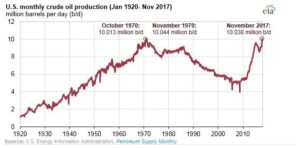by PennEnergy Editorial Staff, February 2, 2018
U.S. crude oil production reached 10.038 million barrels per day (b/d) in November 2017, according to EIA’s latest Petroleum Supply Monthly. November’s production is the first time since 1970 that monthly U.S. production levels surpassed 10 million b/d and the second-highest U.S. monthly oil production value ever, just below the November 1970 production value of 10.044 million b/d.
Within the Lower 48 states, November 2017 production reached a record high in Texas at 3.89 million b/d, followed by North Dakota at 1.18 million b/d. Production in the Federal Gulf of Mexico reached 1.67 million b/d, up 14% from the October 2017 level as the region recovered from Hurricane Nate.

by University of Cap Town, March 12, 2018 in ScienceDaily
-
Early modern humans living in South Africa around 74,000 years ago prospered through the cataclysmic eruption of the Toba supervolcano in Sumatra. The Toba eruption was one of the Earth’s most explosive volcanic events. The environmental effects of this event have been heavily debated, with some researchers having previously proposed that the eruption led to a worldwide volcanic winter that devastated contemporaneous human populations.
An eruption a hundred times smaller than Mount Toba — that of Mount Tambora, also in Indonesia, in 1815 — is thought to have been responsible for a year without summer in 1816. The impact on the human population was dire — crop failures in Eurasia and North America, famine and mass migrations. The effect of Mount Toba, a super-volcano that dwarfs even the massive Yellowstone eruptions of the deeper past, would have had a much larger, and longer-felt, impact on people around the globe (…)
by K. Richard, March 12, 2018 in NoTricksZone
(…) “A recent aerial survey of the Southern Hudson Bay subpopulation concluded that the abundance of polar bears has remained steady since 1986 (943 bears; SE: 174) (Obbard et al., 2015). The survey included the entire coastal range and offshore island habitat of the Southern Hudson Bay subpopulation, except for the eastern James Bay coast. Taken together, the results of the aerial survey and the participant responses from Wemindji and Chisasibi indicate that the local population has remained stable. However, the unanimous responses from participants in Whapmagoostui/Kuujjuarapik suggest that there has been a localized increase in the number of bears near Whapmagoostui/Kuujjuarapik.”
by Dr. B. Peiser, March 12, 2018 in ClimateChangeDispatch
Greens fear that optimism will foster complacency and hence undermine activism. But I find the essays of Pinker and Boisvert inspiring, not enervating.
I plan to assign the essays to my students, who have become quite gloomy lately. These days, despair is a bigger problem than optimism. —John Horgan, Scientific American, 8 March 2018

by Connaissance des Energies, 12 mars 2018
L’ Alliance solaire internationale est une initiative lancée par l’Inde et la France lors de la COP21 qui vise à « augmenter de manière significative la production d’électricité solaire » dans les 121 pays situés en totalité ou en partie entre les tropiques du Cancer et du Capricorne (des pays en voie de développement pour la grande majorité).
(…)
En juin 2017, l’Alliance solaire internationale indiquait que 33 pays avaient signé son accord-cadre et que 6 l’avait ratifié : l’Inde, la France et 4 territoires insulaires (Fidji, Maurice, Nauru, Tuvalu)(5). Il est nécessaire que 15 pays ratifient cet accord-cadre pour qu’il entre en vigueur. En mars 2018, l’Alliance solaire internationale a été officiellement lancée à New Delhi, en présence d’Emmanuel Macron et d’une vingtaine de dirigeants d’Asie, d’Afrique et d’Océanie.
Le gouvernement indien s’est engagé à abriter le secrétariat de l’Alliance solaire internationale pour une durée de 5 ans (jusqu’en 2021).
La géologie, une science plus que passionnante … et diverse


